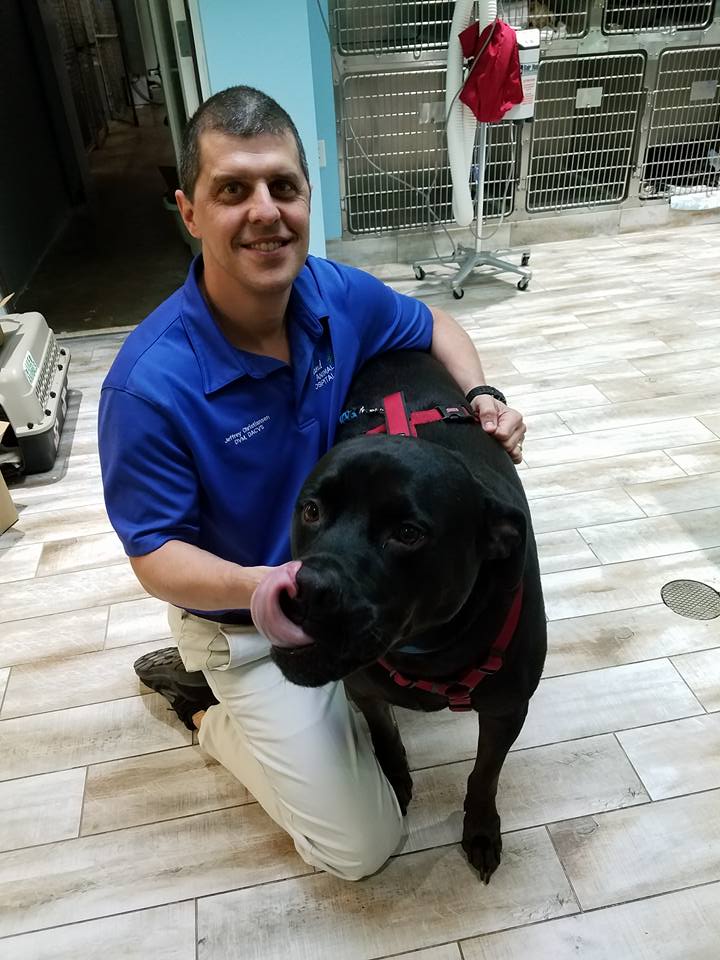Veterinarian Highlight: Dr. Jeff Christiansen, DVM, DACVS

In this week’s blog, we’d like to introduce you to one of our many VetStem Credentialed Veterinarians, Dr. Jeff Christiansen. Dr. Christiansen is a traveling surgeon that works out of Aloha Pet and Bird Hospital, Island Animal Hospital, Animal Specialty and Emergency Hospital, Maybeck Animal Hospital and a number of other veterinary hospitals. While he primarily works in Central Florida, Dr. Christiansen gets referrals from all over Florida and occasionally some other states including Georgia, Alabama, North Carolina, Pennsylvania, New York, and even Wisconsin! His company, Superior Veterinary Surgical Solutions, was founded in July 2014, though he’s been practicing veterinary medicine since 1996. Dr. Christiansen has been a board-certified veterinary surgeon since 2002 and is experienced in all manners of soft tissue, orthopedic, and spinal surgery.
Though VetStem credentialed since 2008, Dr. Christiansen treated his first stem cell patient in 2012. Since then, Dr. Christiansen has treated over 100 patients utilizing VetStem Regenerative Cell Therapy and, as such, is a member of the VetStem Centennial Club. In addition to VetStem Regenerative Cell Therapy, Dr. Christiansen provides platelet therapy utilizing the Pall Veterinary Platelet Enhancement Therapy (V-PET™) kit. Dr. Christiansen has been using V-PET™ since 2015.
We were able to tear Dr. Christiansen away from his busy schedule to get a little insight on how he uses VetStem Cell Therapy. See his interview below:
- What do you like about stem cell therapy and why did you choose VetStem as your service provider?
I like the idea of improving the ability of a pet to heal and to control inflammation.
When we perform orthopedic surgery, the implants we use have a finite/limited ability to tolerate stress before breaking. The sooner a pet’s body heals, the sooner the pet is out of the risk for such problems.
When I do joint surgery, I know I am improving the pet’s comfort and function, but they still get arthritis over time (just a lot more slowly than without surgery); but stem cell therapy can help the pet reduce the arthritis, and protect (and potentially repair) the cartilage, and it improves the pet’s short and long-term comfort and function.I chose VetStem for two simple reasons: Unparalleled quality control and client support.
I see videos and hear reports of other stem cell companies that don’t practice sterile technique, and they are harvesting/processing the tissue in the same room in which hospitalized patients are contained, complete with the airborne hair and patient waste. VetStem has tissue harvested sterilely, processes it sterilely, examines it under the microscope to inspect the quality/sterility, and performs additional bacterial or other testing as indicated.
Any time I have questions or concerns, I get rapid and complete responses from the appropriate staff members, and even the CEO of the company as indicated.
Service is without fail. If I place an order, I get what I want, when I ordered it, always properly shipped, climate-controlled, protected, labeled, etc.
- How do you select your stem cell cases? What criteria must they meet before you recommend stem cell therapy?
I recommend stem cell therapy with any orthopedic surgery or as a treatment option for arthritis. I also recommend stem cell therapy for cases with spinal problems as well as for issues with kidneys, lungs, intestines.
The pet must be healthy enough to tolerate a brief, minor surgical harvest, as well as an expectation to live long to enjoy the benefit of the therapy. I don’t recommend for patients with cancer or systemic infection.
I also make sure the owner is realistic. Stem Cells can do great things, and sometimes a nearly crippled pet can play like a puppy again, but I make sure the owner appreciates the limitations of any therapy.
- Any advice for pet owners considering stem cell therapy for their pet?
Most people appreciate holistic, natural options for their pets. If you could do something that would improve (and potentially extend) your pet’s daily and long-term comfort and quality of life without drugs and further surgery, wouldn’t you do it?
I would also strongly encourage pet owners to get pet insurance. Because the benefits with stem cell therapy are so clear-cut, at least with arthritis, many insurance companies pay most or all of the cost of stem cell therapy.
Thanks, Dr. Christiansen, for taking the time to speak with us! If you live in or around Florida and are considering stem cell therapy for your pet, you are in excellent hands with Dr. Jeff Christiansen!


 “Canine Back Pain” is a broad term that encompasses pain felt in any location along a dog’s back. Because the back is such a complex structure, this pain can result form a variety of causes which may be difficult and costly to diagnose. Spinal structures, nerves, and the surrounding soft tissues may all be involved as sources of canine back pain, but the exact location may be hard to pinpoint.
“Canine Back Pain” is a broad term that encompasses pain felt in any location along a dog’s back. Because the back is such a complex structure, this pain can result form a variety of causes which may be difficult and costly to diagnose. Spinal structures, nerves, and the surrounding soft tissues may all be involved as sources of canine back pain, but the exact location may be hard to pinpoint. “Gracie is doing great. She now stands on her hind legs to look over fences. It was something she used to do and it hadn’t dawned on me that she had stopped until she started looking over a wood fence for Annie (Bulldog) when we go on our walks. She sometimes jumps off our front porch and back on instead of using the step and she flies up and down stairs in the house. She will stand on her hind legs and does a dog paddle when I ask her ‘what do horses do’ and sits on her bottom (with front legs off the ground) and dog paddles when I ask her to ‘sit pretty’ and ‘sit pretty patty cakes’. I had stopped asking her to do these tricks since it became obvious that she didn’t want to do them, but now she will start the trick before I finish the question. She oozes happy . . . which makes us very happy.”
“Gracie is doing great. She now stands on her hind legs to look over fences. It was something she used to do and it hadn’t dawned on me that she had stopped until she started looking over a wood fence for Annie (Bulldog) when we go on our walks. She sometimes jumps off our front porch and back on instead of using the step and she flies up and down stairs in the house. She will stand on her hind legs and does a dog paddle when I ask her ‘what do horses do’ and sits on her bottom (with front legs off the ground) and dog paddles when I ask her to ‘sit pretty’ and ‘sit pretty patty cakes’. I had stopped asking her to do these tricks since it became obvious that she didn’t want to do them, but now she will start the trick before I finish the question. She oozes happy . . . which makes us very happy.”

 Stuart is a fun-loving Labrador that, like most Labs, loves to play fetch. In 2017, when Stuart began showing signs of an injury, his owner, Cynthia, took him to her veterinarian, Dr. Cindy Echevarria at
Stuart is a fun-loving Labrador that, like most Labs, loves to play fetch. In 2017, when Stuart began showing signs of an injury, his owner, Cynthia, took him to her veterinarian, Dr. Cindy Echevarria at 
 milar to storing your baby’s stem cells at birth, the canine
milar to storing your baby’s stem cells at birth, the canine 
